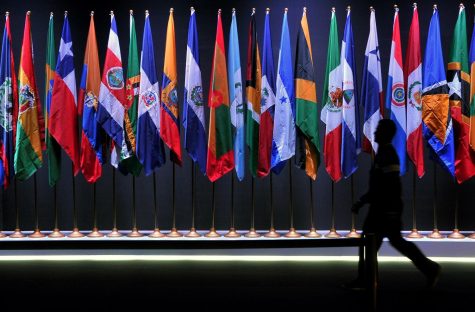Phoneless Friday: A day disconnected
May 4, 2016
A whole day without your cell phone. It’s a scary thought, right? Can you imagine: no Instagram, no Twitter, no emails, no texting and you have to make actual phone calls. Sounds like a living hell to any millennial. But I did it.
I chose a Friday, but preparations started the night before. I had to search for my old alarm clock, it was gone. The struggle to not use my phone for 24 hours was already starting off horribly, and the actual day hadn’t even begun yet.
I called my aunt, who is in her 40s, to see if she had an alarm clock I could use, and luckily she did. After I picked up the alarm clock from her, I put my phone on “Do Not Disturb” mode so I wouldn’t hear it go off all day on Friday. I told all my friends to call my house phone, or to email me on Friday.
I then had to charge my iPod the night before because I wouldn’t be able to take my phone with me to the gym for music. I hadn’t updated my iPod in a year or so because I use Spotify on my phone all the time, so my playlists were going to be at least a year old.
But there was no turning back: I was going phoneless on Friday.
Friday morning, I wake up late because I set my new alarm clock incorrectly the night before. At 8:30 a.m., my first mini-internal panic attack hit when I got out of my car, walking into the gym because I am assuming that I lost my phone. “Nope,” I reminded myself, “It’s at home in your desk.”
Normally, I stop to check emails and texts while I work out, stretching my gym time to about an hour and 15 minutes. But without the phone distractions, I finish in 45 minutes.
The fact that I woke up late didn’t even matter anymore — I had just made up for lost time with an uninterrupted workout.
Americans now spend an average of 4.7 hours a day on their smartphones, according to a Seattle-based Informate Mobile Intelligence group, reported the Washington Times, and that fact seemed correct when I was at the gym. Probably 50 percent of the people at my gym had their heads down, focused on their phones.
After I returned home, the urge to grab my phone and check is almost too much to bear. But, I open up my laptop and answer my emails — most of them from my friends saying how crazy I am for not using my phone and to call them in the early afternoon. However, I couldn’t just call them. I didn’t have their phone numbers written down and don’t have them memorized. I email them back, and tell them to call me or give me their numbers so I can call them.
The struggle is real.
Apparently, everyone hates phone calls. And no one seems to answer a number they don’t know. A friend of mine and I set a tentative time to meet later that day. The instructions went as follows: She will pick me up at around 5:00 p.m. We go out to dinner, then we watch the Stanley Cup Playoff hockey games that evening. I would wait by the phone, literally, for her to call me to tell me she is on her way.
While I wait for the evening to roll around, I decide that this day would be the best day to get caught up on reading for my classes and finish up some homework so I could enjoy my weekend. I finish reading a book and writing a subsequent summary for a class, finish my online work for another and read up on current events for yet another class. Since the forecast was rain all day, it was all adding up and making perfect sense; it is unbelievable how much work one can get done if they just put their phone away.
In a 2015 study, Dr. Larry Rosen, a research psychologist and a professor of psychology at California State University Dominguez Hills, asked 263 students to go into their normal study environments. They became distracted by their phones in the first two minutes while working on a school assignment. The students spent only sixty-five percent of their time on schoolwork, according to Rosen’s study.
When lunch time rolls around, I didn’t bother to ask anyone to join me because I don’t want to wait around for them to email me back. If I wait even for just one person to answer their phone, I feel like I would have to wait around forever.
I sit down at Mr. Pickles and notice how everyone around me has their necks hunched over, staring at their little screens — even those with people sitting at the table with them. They converse, but don’t make eye contact. They keep their heads down, only to look up occasionally when one would want to show the other something on their phone. The average American spends practically every waking minute using some type of electronic device, according to a 2010 study by the Kaiser Family Foundation, reported The New York Times.
Insert second mini-internal panic attack when I get home from lunch. I think I left my phone in the sandwich shop. I almost Google the phone number to call and ask if anyone turned a phone in, but then realize, “Nope, it’s in your desk.” I would go on to mutter this mantra to myself 50 times throughout the day.
Fast forward to me sitting next to my mom’s landline phone, waiting by to be picked up to go grab dinner and to watch hockey. At 5:30 p.m. I call up my girlfriend, but no answer.
Three phone calls later she picks up: “Oh hey! Did you get my text? I said I was going to be there at six instead of five. And what number are you calling me from?”
Me: “I don’t have my phone all day, remember? We talked about this earlier. This is my house phone.”
Her: “Oh yeah. Girl get your phone when I pick you up. This is too hard to communicate with you! See you soon!” *Click*
It’s not too hard. It’s just not as convenient for you, I think to myself. We head out to dinner and meet up with the group. I notice that when I go to hug everyone, they all have their phones in their hands. After we sit, everyone’s head is down in their phones, but yet, still having conversation with one another.
I think, “Hey guys. I’m here. Want to make eye contact when speaking to me?”
The term “text neck” comes to mind at dinner. Spine-Health, a group of medical professionals that focus on helping those with constant neck and back pain research, describes “text neck” as one of the most common causes of neck pain and soreness. Looking down at your phone too much can lead to upper back pain that ranges anywhere from a chronic, nagging pain to a sharp upper back spasms, according to Spine Health.
Insert a third mini-panic attack during our night out. I think I’ve lost my phone yet again. One of my friends reminds me I’ve gone “phoneless” and laughs at me.
I feel like I forgot something all night. I feel left out because all my friends are talking about what was happening in the social media world, a world I had left behind for a day. But then I also hate that I can’t hold a conversation with any of them because all they are talking about is what is happening on their phones.
I want to talk about what was happening during the live hockey games, or if anything exciting happened during their day. To have an actual conversation and make eye contact. But they want to talk about what so-and-so said about the hockey games, what someone is posting on Instagram or what this person said on Twitter.
By the end of the night, I feel more annoyed than relieved to go back home and check my phone at midnight. Instead of grabbing it instantly, scouring all my social media apps and checking my phone to see everything that I “missed out” on, I set my aunt’s alarm clock and left my phone in the drawer. I will check it when I wake up.
What would it hurt to wait a few more hours before becoming addicted all over again?















